B2B and B2C copywriting are much closer to one another than you might think. Here are four reasons why.
“I hired a copywriter without checking if he was specialised in B2B writing”, confessed a fellow entrepreneur to me recently.
“It didn’t go well”, she continued, explaining that while the blogs and email sequences written were engaging and of good quality, they failed to speak to the business audience she was hoping to attract.
As I’m sure we can all agree, that doesn’t sound like a successful content marketing collaboration.
However, I dare to claim that the problem was not necessarily in the fact that the writer was not a B2B content creator.
After all, writing to ambitious CEO’s is not so different from writing to worn-out parents of triplets. While we often talk about B2B, B2C or even B2B2C marketing as separate and different things, when it comes to copywriting, different B’s and other acronyms don’t matter that much.
There are four much more important things to pay attention to.
B2B vs. B2C Audience: Different on the surface, similar deep within
Let’s dig deeper into these four elements that make a big difference in copywriting. How are they different in B2B and B2C writing – or are they?
Audience – What stays the same
The copywriting process starts with getting to know the ideal client or reader of the text.
While the client persona might change quite a lot from businesses to consumers and government officials, the process itself stays the same. Whether your client is tackling time management of a team of high achievers, or a feeding schedule for a litter of puppies, the first questions to ask are similar.
What are their pain points? How are they perceiving the problem and talking about it? What kind of solutions are they currently using? How can we help them succeed?
Business copywriting is about meeting a potential client where they are and helping them get to the place where they can make an educated buying decision. The first step is to find out where they are and how they think about being there – whoever they are.
Audience – What changes
When writing B2B copy, get very clear about who the target audience is. Whose attention are you trying to get?
In the business context, the reader of your text is not always the decision maker. That’s why it’s important to get to know that person and their pain points, which might be different from the general benefits of your product and service.
Align the goal with the sales stage
The second step in the process is to understand the different stages of a sales cycle and make sure that content matches the business goal.
Goal – What stays the same
The digital sales cycle starts from the awareness stage, where a potential client finds out about your business or a problem they want to solve. They move from consideration to purchase, and ideally, from there to retention and advocacy.
Each piece of copy should be aimed at a certain phase in the cycle. In the awareness phase, a future client might be interested in Do-It-Yourself tools to organise their team’s project calendar and what to take into account.
But when they are ready to make a decision about buying consultancy services, DIY tips won’t suffice anymore.
Goal – What changes
Often, especially with lower-price point products, the cycle can be very quick. However, in a B2B context, it can take longer and involve several people.
Ensure that each piece of content speaks to that specific phase and to the person in charge, and share this vital information with your copywriter.
B2B Tone of Voice: Is there such a thing?
The next question to ask is about the tone of voice. What kind of relationship are you building with your future clients and how do you want them to feel when working with you?
Tone of Voice – What stays the same
The tone of voice should reflect the identity of your brand, but there is no such thing as a B2B tone of voice or a B2C tone of voice.
Some B2B services want to identify themselves as a friendly and informal partner, while some consumer brands want to stay formal and distant. Stay loyal to your brand.
Tone of Voice – What changes
In highly specialised fields, understanding and knowing how to use industry lingo is vital. Writing about scientific research, for example, requires in-depth knowledge of the field. For this reason, many industries use specialised copywriters who often have a background in the field as well.
For most areas, though, a skilled copywriter is capable of adjusting their tone and vocabulary to the task at hand and fill any potential gaps by interviewing and doing research. Having an outsider’s perspective can even help express complicated ideas in a fresh and understandable way.
Being available for questions and giving candid feedback are valuable and guarantee that both the substance and the tone of messaging stay on course.
Strategic Calls-to-Action
Finally, let’s talk about calls-to-action. Is nudging consumers forward in the sales process different from professionals?
Call-to-Action – What stays the same
The general rule that applies to all audiences: use calls-to-action consistently in every piece of content. Lacking or unclear CTA’s are one of the most common stumbles that keep businesses from getting the results they are looking for in their content marketing campaigns.
Call-to-Action – What changes
On the other hand, just sprinkling CTA’s on the top of a great piece of copy won’t work because they need to be aligned with the client’s pain points and the phase of the sales cycle they are in. As sales processes might be longer and more complicated in the B2B setting, the CTA’s need to reflect that.
In a short sales cycle, the CTA can be from the start Buy now, Sign up or Grab This Deal. In longer processes it evolves from Read This Article to Download Your Guide and Book a Demo.
Settling the score: Is B2B Writing different from B2C?
As we’ve seen, basic rules of copywriting don’t change from one audience to the next. The questions to ask are the same, just the answers change.
Whether you and your team are doing the writing or you’re using external support, getting clear about each of the steps helps you get better results through your content – be it social media captions, blogs, ebooks or something else.
What would you like to know about copywriting or working with a freelance writer? Drop your question in the comments or email me! I’m writing more about the topic in the coming weeks and months, and I’d love to know what you’re thinking.







Recent Comments